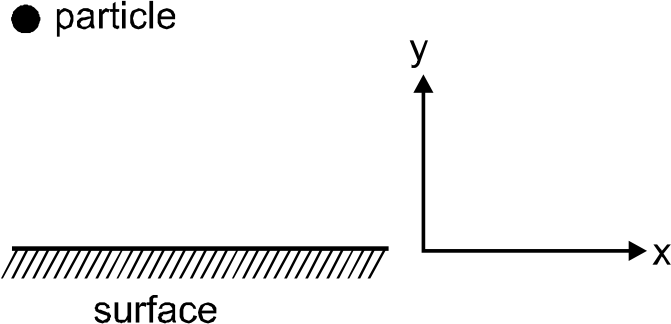A particle moving with a velocity of (4ˆi−ˆj ) mis strikes a fixed smooth wall and finally moves with a velocity of (3ˆi+2ˆj) m/s. The coefficient of restitution between the wall and the particle in the collision will be
73
37
√1317
√1713
The correct Answer is:B
To find the coefficient of restitution (e) between the wall and the particle after the collision, we can follow these steps:
Step 1: Identify the initial and final velocities
The initial velocity of the particle before striking the wall is given as:
vi=4^i−^jm/s
The final velocity of the particle after striking the wall is given as:
vf=3^i+2^jm/s
Step 2: Calculate the change in velocity
The change in velocity (Δv) can be calculated as:
Δv=vf−vi
Substituting the values:
Δv=(3^i+2^j)−(4^i−^j)
Δv=(3−4)^i+(2+1)^j
Δv=−^i+3^j
Step 3: Calculate the velocity of separation
The velocity of separation is the component of the final velocity in the direction of the wall. The wall is smooth, so it only affects the component of velocity perpendicular to its surface.
To find the velocity of separation, we need to project the final velocity onto the normal direction of the wall. In this case, we can assume the wall is vertical, so the normal direction is along the x-axis (i.e., ^i).
The final velocity in the direction of the normal is:
vf,n=vf⋅^i=3^i+2^j⋅^i=3m/s
The initial velocity in the direction of the normal is:
vi,n=vi⋅^i=4^i−^j⋅^i=4m/s
Step 4: Calculate the coefficient of restitution
The coefficient of restitution (e) is defined as the ratio of the relative speed after collision to the relative speed before collision along the normal direction:
e=vf,nvi,n
Substituting the values we calculated:
e=34
Final Answer
Thus, the coefficient of restitution between the wall and the particle is:
e=34
---
The initial velocity of the particle before striking the wall is given as:
vi=4^i−^jm/s
vf=3^i+2^jm/s
The change in velocity (Δv) can be calculated as:
Δv=vf−vi
Substituting the values:
Δv=(3^i+2^j)−(4^i−^j)
Δv=(3−4)^i+(2+1)^j
Δv=−^i+3^j
The velocity of separation is the component of the final velocity in the direction of the wall. The wall is smooth, so it only affects the component of velocity perpendicular to its surface.
vf,n=vf⋅^i=3^i+2^j⋅^i=3m/s
vi,n=vi⋅^i=4^i−^j⋅^i=4m/s
The coefficient of restitution (e) is defined as the ratio of the relative speed after collision to the relative speed before collision along the normal direction:
e=vf,nvi,n
e=34
Thus, the coefficient of restitution between the wall and the particle is:
e=34
Topper's Solved these Questions
- BOOK - RESNICK AND HALLIDAYCHAPTER - CENTER OF MASS EXERCISE - Practice Questions (More than One Correct Choice)5videos
CENTER OF MASS
- BOOK - RESNICK AND HALLIDAYCHAPTER - CENTER OF MASS EXERCISE - Practice Questions (Linked Comprehension)6videos
CENTER OF MASS
- BOOK - RESNICK AND HALLIDAYCHAPTER - CENTER OF MASS EXERCISE - Problems46videos
CENTER OF MASS
- BOOK - RESNICK AND HALLIDAYCHAPTER - CAPACITANCEEXERCISE - PRACTICE QUESTION (INTEGER TYPE)3videos
CAPACITANCE
- BOOK - RESNICK AND HALLIDAYCHAPTER - CIRCUITSEXERCISE - Practice Questions (Integer Type)3videos
CIRCUITS
Similar Questions
A small sphere of mass m=1kg is moving with a velocity (4ˆi−ˆj)m/s. it hits a fixed smooth wall and rebounds with velocity (ˆi+3ˆj)m/s. The coefficient of restitution between the sphere and the wall is n/16. Find the value of n.
View SolutionA particle of mass 'm' moving with a velocity of (4ˆi−ˆj)m/s strikes a fixed wall and finally moves with a velocity of (3ˆi+2ˆj)m/s. Find
(a) the impulse received by the particle.
(b) the coefficient of restitution between them in the collision.View Solution
Knowledge Check
- Question 1 - Select One
A small sphere of mass 1kg is moving with a velocity (6ˆi+ˆj)m/s . It hits a fixed smooth wall and rebounds with velocity (4ˆi+ˆj)m/s. The coefficient of restitution between the sphere and the wall is
A32B23C916D49 - Question 2 - Select One
A particle moving with velocity (2ˆi−3ˆj) m/s collides with a surface at rest in xz–plane as shown in figure and moves with velocity (2ˆi+2ˆj) m/s after collision. Then coefficient of restitution is :
 A23B1C√813D45
A23B1C√813D45 - Question 3 - Select One
A smooth sphere is moving on a horizontal surface with velocity vector 3ˆi+ˆj immediately before it hits a vertical wall. The wall is parallel to the vector ˆj and the coefficient of restitution between the wall and the sphere is 1/3. The velocity vector of the sphere after it hits the wall is :
A3ˆi−13ˆjB−ˆi+ˆJCˆi−ˆjD−ˆi−13ˆj
A particle of mass m moving with a velocity (3ˆi+2ˆj)ms−1 collides with another body of mass M and finally moves with velocity (−2ˆi+ˆj)ms−1. Then during the collision
View SolutionA force of (5ˆi+6ˆj) N makes a body to move on a rough surface with a velocity of (4ˆj−2ˆk) m/s. What is the power?
View SolutionA small sphere of mass m=2kg moving with a velocity ¯u=4ˆi−7ˆjm/s colides with a smooth wall and returns with a velocity ¯v=−ˆi+3ˆjm/s. The magnitude of the impulse received by the ball is .
View SolutionA particle strikes a smooth horizontal surface at an angle of 45∘ with a velocity of 100m/s and rebounds. If the coefficient of restitution between the floor and the particle is 0.57 then the angle which the velocity of the particle after it rebounds will make with the floor is
View SolutionA smooth sphere of mass m is moving on a horizontal plane with a velocity (3ˆi+ˆj) . It collides with smooth a vertical wall which is parallel to the vector ˆj . If coefficient of restitution e=12 then impulse that acts on the sphere is
View Solution

